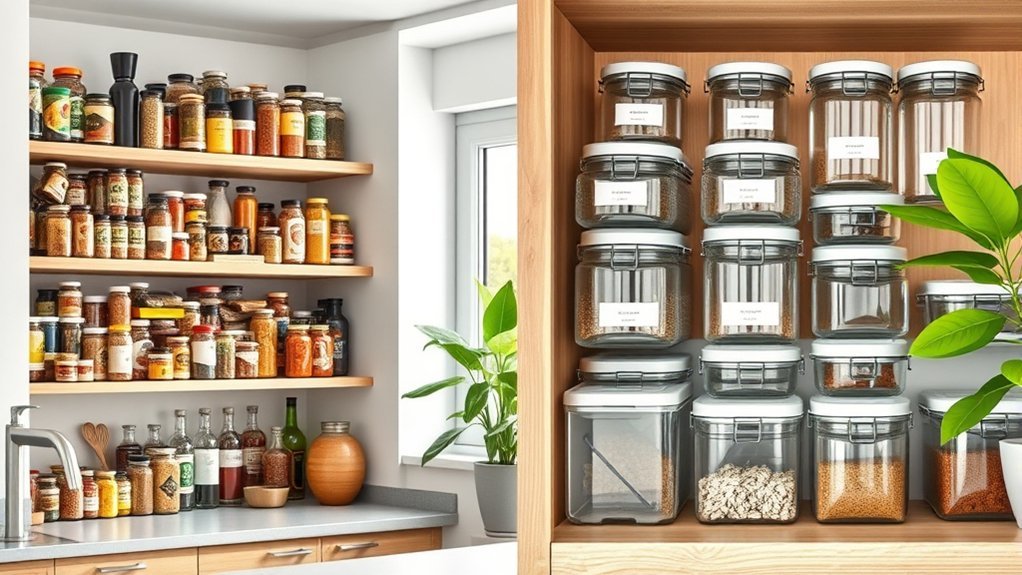When it comes to storage hacks, it’s easy to fall for common myths that can lead to frustration. You might think that simply having more space will solve your clutter issues, but that’s not always the case. Instead, understanding how to effectively use vertical space and prioritize organization can make a significant difference. Curious about the real strategies that can help you maximize your storage?
Common Storage Myths Debunked
When it comes to storage solutions, many people fall for common myths that can lead to poor decision-making. One myth is that more space equals better organization. In reality, clutter can still accumulate in larger areas.
Another misconception is that you should fill every inch of storage; overstuffing can hinder accessibility. Many believe that clear bins are the best choice, but opaque options can help hide unsightly items, creating a more visually appealing space.
Overstuffing storage hinders access; sometimes, opaque bins create a more appealing and organized space than clear ones.
You might think labeling every box is essential, but prioritizing categories instead can streamline your system. Ultimately, it’s about functionality and ease, not just maximizing space.
Busting these myths empowers you to create a storage system that truly liberates your space and mind.
The Truth About Vertical Space Utilization
Although you may think horizontal space is all that matters, utilizing vertical space can considerably enhance your storage efficiency. By maximizing vertical areas, you free up valuable floor space, making your environment feel more open and organized.
Install shelves, pegboards, or wall-mounted racks to keep items off surfaces and within easy reach. Consider tall bookcases or stacking bins for added height storage. Use hooks for bags or tools, keeping them visible and accessible.
Don’t forget about the ceiling; overhead storage can hold seasonal items or rarely used equipment. Embracing vertical storage isn’t just practical—it releases your space, allowing you to breathe and enjoy your surroundings more fully.
Decluttering: Sorting vs. Organizing
Decluttering effectively hinges on understanding the difference between sorting and organizing. Sorting is about categorizing items into piles, while organizing involves arranging these items in a way that makes them easily accessible and visually appealing.
Here’s a simple comparison to guide you:
| Sorting | Organizing |
|---|---|
| Temporary process | Permanent solution |
| Focus on categorization | Focus on functionality |
| May create clutter | Reduces clutter |
To liberate your space, start with sorting—group items you want to keep, donate, or discard. Once you’ve sorted, focus on organizing what remains, ensuring everything has a designated place. This approach will help you create a harmonious environment.
The Role of Clear Storage Containers
Clear storage containers play an essential role in maintaining an organized space. They allow you to see what’s inside at a glance, eliminating the frustration of digging through opaque boxes.
With their uniform shape, these containers stack easily, maximizing vertical space and keeping your area tidy. Whether you’re storing seasonal clothes, craft supplies, or kitchen items, clear containers help you categorize without losing sight of your belongings.
Using labels can enhance their effectiveness, letting you quickly locate items when you need them. Plus, their versatility means you can use them in any room, from closets to garages.
Creative Solutions for Small Spaces
Finding creative solutions for small spaces can transform how you live and work. Maximizing every inch in your environment allows for greater freedom and functionality.
Here are some clever ideas to contemplate:
- Multi-functional furniture: Invest in pieces like ottomans with storage or foldable tables that adapt to your needs.
- Vertical storage: Use wall-mounted shelves or hooks to keep items off the floor and give the illusion of more space.
- Under-bed storage: Utilize the space beneath your bed with bins or drawers, keeping your essentials organized yet out of sight.
Frequently Asked Questions
How Often Should I Reorganize My Storage Spaces?
You should reorganize your storage spaces every six months. Regularly evaluating and revitalizing your organization helps maintain clarity and functionality, ensuring you easily find what you need and keep clutter at bay.
Are There Any Tools to Help With Decluttering?
Yes, you’ve got options! Try decluttering tools like clear bins, label makers, or even apps that track items. Visualize your space transforming, making it easier to organize, breathe, and enjoy your surroundings.
What Are the Best Materials for Storage Containers?
The best materials for storage containers are durable plastic, breathable fabric, and sturdy metal. They offer protection, organization, and longevity. Choose clear containers for visibility, or label them for easy access and streamlined decluttering.
Can I Store Seasonal Items in My Garage?
Storing seasonal items in your garage is like tucking away memories in a time capsule. Just guarantee they’re in airtight containers away from moisture and extreme temperatures, so they stay safe and ready for next season.
How Do I Prevent Pests in My Storage Areas?
To prevent pests in your storage areas, seal containers tightly, keep items off the floor, use natural repellents, maintain cleanliness, and check for signs of infestation regularly. You’ll create a pest-free environment.
Conclusion
In the world of storage, think of your space as a blank canvas. Just like an artist chooses colors carefully, you need to select the right strategies for your home. Ditch the myth that more space equals better organization; instead, embrace verticality and clever categorization. With clear containers as your palette, you can paint a picture of order and efficiency. By understanding these truths, you’ll transform clutter into clarity, creating a harmonious living space that reflects your style.
